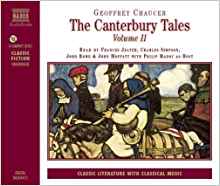-
The Canterbury Tales of Geoffrey Chaucer
Geoffrey Chaucer, D. Laing Purves, Paul A. Boer Sr.
Paperback (CreateSpace Independent Publishing Platform, April 28, 2014)The Canterbury Tales (Middle English: Tales of Caunterbury) is a collection of over 20 stories written in Middle English by Geoffrey Chaucer at the end of the 14th century, during the time of the Hundred Years' War. The tales (mostly written in verse, although some are in prose) are presented as part of a story-telling contest by a group of pilgrims as they travel together on a journey from Southwark to the shrine of Saint Thomas Becket at Canterbury Cathedral. The prize for this contest is a free meal at the Tabard Inn at Southwark on their return. After a long list of works written earlier in his career, including Troilus and Criseyde, House of Fame, and "Parliament of Fowls", The Canterbury Tales was Chaucer's magnum opus. He uses the tales and the descriptions of its characters to paint an ironic and critical portrait of English society at the time, and particularly of the Church. Structurally, the collection resembles The Decameron, which Chaucer may have read during his first diplomatic mission to Italy in 1372. It is sometimes argued that the greatest contribution that this work made to English literature was in popularising the literary use of the vernacular, English, rather than French or Latin. English had, however, been used as a literary language for centuries before Chaucer's life, and several of Chaucer's contemporaries—John Gower, William Langland, and the Pearl Poet—also wrote major literary works in English. It is unclear to what extent Chaucer was responsible for starting a trend rather than simply being part of it.
-
The Canterbury Tales
Geoffrey Chaucer
Paperback (Nick Hern Books, March 15, 1634)None
-
The Canterbury Tales of Geoffrey Chaucer
R M (translator) Chaucer, Geoffrey; Lumiansky
Paperback (Washington Square Press, Jan. 1, 1967)None
-
The Canterbury Tales Of Geoffrey Chaucer
Walter Appleton Clark Geoffrey Chaucer, Percy MacKaye
Hardcover (Facsimile Publisher, Jan. 1, 2015){Size: 18.78 x 25.13 cms} Lang: - English, Pages 267. Reprinted in 2015 with the help of original edition published long back [1914]. This book is Printed in black & white, Hardcover, sewing binding for longer life with Matt laminated multi-Colour Dust Cover, Printed on high quality Paper, re-sized as per Current standards, professionally processed without changing its contents. As these are old books, we processed each page manually and make them readable but in some cases some pages which are blur or missing or black spots. If it is multi volume set, then it is only single volume, if you wish to order a specific or all the volumes you may contact us. We expect that you will understand our compulsion in these books. We found this book important for the readers who want to know more about our old treasure so we brought it back to the shelves. Hope you will like it and give your comments and suggestions. Complete Title: The Canterbury tales of Geoffrey Chaucer 1914 [Hardcover]. Author: Geoffrey Chaucer, Percy MacKaye, Walter Appleton Clark
-
The Canterbury Tales of Geoffrey Chaucer. Together with a Version in
William CHAUCER,Geoffrey & VAN WYCK
HardcoverNone
-
The Canterbury Tales of Geoffrey Chaucer
Geoffrey Chaucer, Percy Mackaye
Hardcover (Literary Licensing, LLC, March 29, 2014)This Is A New Release Of The Original 1904 Edition.
-
The Canterbury Tales of Geoffrey Chaucer
R. M. Lumiansky
Paperback (Washington Square Press, Jan. 1, 1965)None
-
Canterbury Tales of Geoffrey Chaucer
Geoffrey Chaucer
Paperback (International Thomson Publishing, June 1, 1976)None
-
Canterbury Tales of Geoffrey Chaucer, The
Geoffrey Chaucer
Hardcover (Hale, Cushman & Flint, March 15, 1928)None
-
The Canterbury Tales of Geoffrey Chaucer Together with a Version in Modern English By William Van Wyck
William Van Wyck Geoffrey Chaucer
Hardcover (Covici-Friede, March 15, 1930)None
-
The Canterbury Tales of Geoffrey Chaucer: A Modern Rendering Into Prose of the Prologue and Ten Tales
Percy Mackaye
Hardcover (Forgotten Books, March 2, 2018)Excerpt from The Canterbury Tales of Geoffrey Chaucer: A Modern Rendering Into Prose of the Prologue and Ten TalesBriefly, then, the method followed has been to present, so far as possi ble, Chaucer's ipsissi/ma verba; to err rather in the direction of literal fidelity than literary license. No archaisms, however, have been retained which are not fairly intelligible. The necessary changes which have been made are: first, omissions on the score of propriety, of intelligibility (as when a long paraphrase would have been required for a trivial matter), and (very seldom) of redundancy; secondly, rare and slight rearrangements for the sake of clearness; thirdly, translation and paraphrase required by clearness and the necessities of prose-style. Proper names have been altered to their classical or modern forms only in the case of historical characters or places fairly familiar to-day. The text of Professor Skeat has been followed almost always and his notes very largely.About the PublisherForgotten Books publishes hundreds of thousands of rare and classic books. Find more at www.forgottenbooks.comThis book is a reproduction of an important historical work. Forgotten Books uses state-of-the-art technology to digitally reconstruct the work, preserving the original format whilst repairing imperfections present in the aged copy. In rare cases, an imperfection in the original, such as a blemish or missing page, may be replicated in our edition. We do, however, repair the vast majority of imperfections successfully; any imperfections that remain are intentionally left to preserve the state of such historical works.
-
Canterbury Tales - Volume II Classic Literature With Classical Music. Classic Fiction by Geoffrey Chaucer
None
Audio CD (Naxos Audio Books, )None